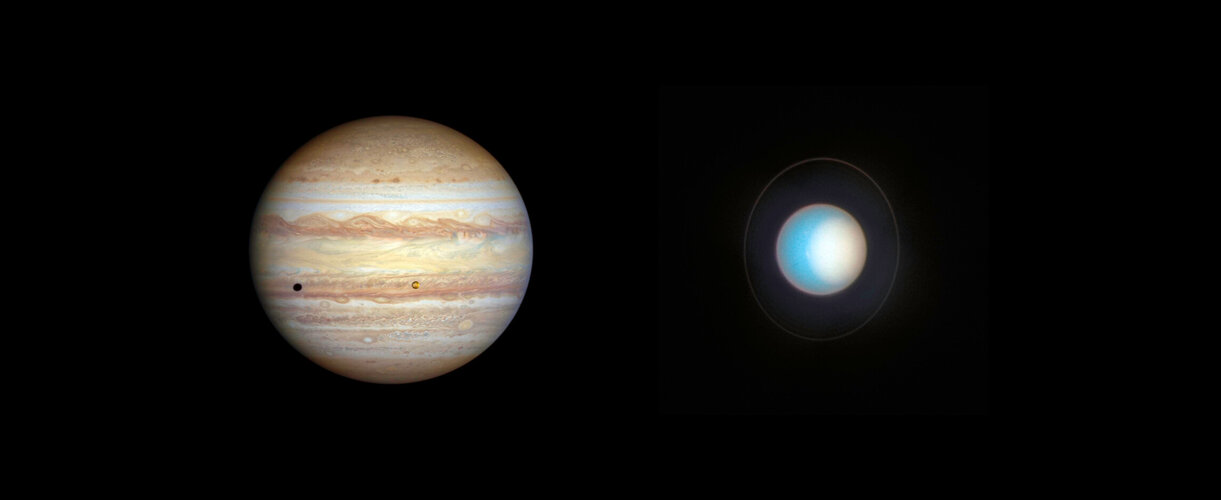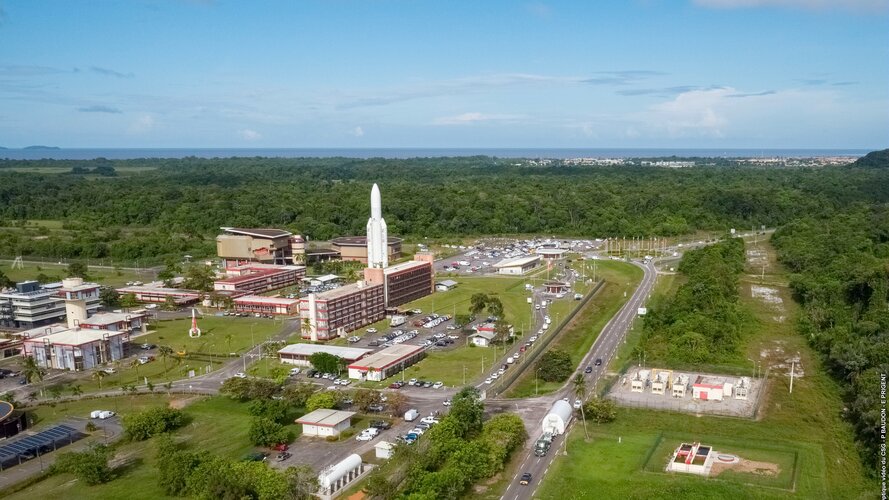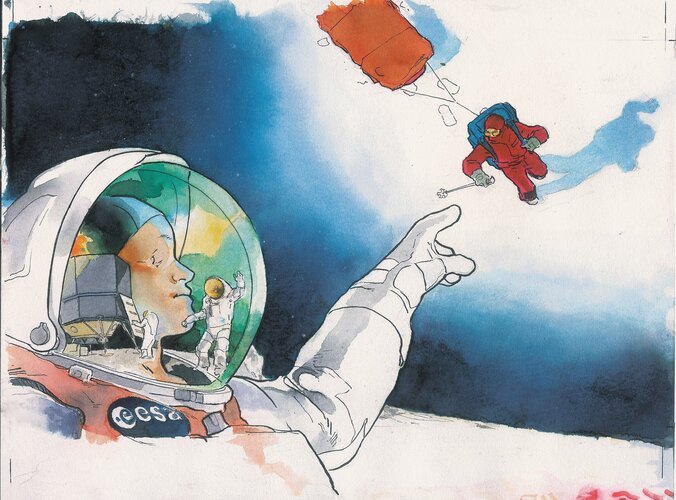
Copernical Team
Thursday, 23 March 2023 13:00
Hubble monitors changing weather and seasons on Jupiter and Uranus

Ever since its launch in 1990, the NASA/ESA Hubble Space Telescope has been an interplanetary weather observer, keeping an eye on the ever-changing atmospheres of the largely gaseous outer planets. And it’s an unblinking eye that allows Hubble’s sharpness and sensitivity to monitor a kaleidoscope of complex activities over time. Today new images are shared of Jupiter and Uranus.
Published in
News
Tagged under
Thursday, 23 March 2023 08:00
Europe’s Spaceport: digitalisation contract opportunities

ESA and CNES invite space and non-space companies from all European Member, Associate and Cooperating States to support the digital modernisation of several activities at Europe’s Spaceport in French Guiana.
Published in
News
Tagged under
Thursday, 23 March 2023 11:07
Independent advisory group presents report on European space revolution to ESA

Published in
News
Tagged under
Thursday, 23 March 2023 10:05
Arkisys Announces Contract Award With US Space Force
Washington DC (SPX) Mar 21, 2023
 Arkisys and partners to demonstrate building and assembling a satellite in orbit on the Port
The U.S. Space Force awarded a $1.6 million contract to Arkisys to demonstrate robotic satellite assembly.
Under a SpaceWERX Small Business Innovation Research contract, Arkisys and its partners, Novawurks, Motiv Space Systems, Qediq, iBoss, and Texas A and M University will demonstrate how t
Arkisys and partners to demonstrate building and assembling a satellite in orbit on the Port
The U.S. Space Force awarded a $1.6 million contract to Arkisys to demonstrate robotic satellite assembly.
Under a SpaceWERX Small Business Innovation Research contract, Arkisys and its partners, Novawurks, Motiv Space Systems, Qediq, iBoss, and Texas A and M University will demonstrate how t
 Arkisys and partners to demonstrate building and assembling a satellite in orbit on the Port
The U.S. Space Force awarded a $1.6 million contract to Arkisys to demonstrate robotic satellite assembly.
Under a SpaceWERX Small Business Innovation Research contract, Arkisys and its partners, Novawurks, Motiv Space Systems, Qediq, iBoss, and Texas A and M University will demonstrate how t
Arkisys and partners to demonstrate building and assembling a satellite in orbit on the Port
The U.S. Space Force awarded a $1.6 million contract to Arkisys to demonstrate robotic satellite assembly.
Under a SpaceWERX Small Business Innovation Research contract, Arkisys and its partners, Novawurks, Motiv Space Systems, Qediq, iBoss, and Texas A and M University will demonstrate how t
Published in
News
Tagged under
Thursday, 23 March 2023 10:05
Metaspectral Selected to join leading Australian Space Program
Adelaide, Australia (SPX) Mar 23, 2023
 Metaspectral, a remote sensing software company advancing computer vision using deep learning and hyperspectral imagery, is announcing that it has been selected to join Venture Catalyst Space.
Venture Catalyst Space is a leading commercial space accelerator and incubator program delivered by the University of South Australia's Innovation and Collaboration Centre (ICC) and is funded by the
Metaspectral, a remote sensing software company advancing computer vision using deep learning and hyperspectral imagery, is announcing that it has been selected to join Venture Catalyst Space.
Venture Catalyst Space is a leading commercial space accelerator and incubator program delivered by the University of South Australia's Innovation and Collaboration Centre (ICC) and is funded by the
 Metaspectral, a remote sensing software company advancing computer vision using deep learning and hyperspectral imagery, is announcing that it has been selected to join Venture Catalyst Space.
Venture Catalyst Space is a leading commercial space accelerator and incubator program delivered by the University of South Australia's Innovation and Collaboration Centre (ICC) and is funded by the
Metaspectral, a remote sensing software company advancing computer vision using deep learning and hyperspectral imagery, is announcing that it has been selected to join Venture Catalyst Space.
Venture Catalyst Space is a leading commercial space accelerator and incubator program delivered by the University of South Australia's Innovation and Collaboration Centre (ICC) and is funded by the
Published in
News
Tagged under
Thursday, 23 March 2023 10:05
A common thread linking subatomic color glass condensate and massive black holes
Washington DC (SPX) Mar 23, 2023
 Physicists have discovered a remarkable correspondence between dense states of gluons-the gluelike carriers of the strong nuclear force within atomic nuclei-and enormous black holes in the cosmos. The dense walls of gluons, known as a color glass condensate (CGC), are generated in collisions of atomic nuclei. This CGC measures a mere 10-19 kilometers across-less than a billionth of a kilometer.
Physicists have discovered a remarkable correspondence between dense states of gluons-the gluelike carriers of the strong nuclear force within atomic nuclei-and enormous black holes in the cosmos. The dense walls of gluons, known as a color glass condensate (CGC), are generated in collisions of atomic nuclei. This CGC measures a mere 10-19 kilometers across-less than a billionth of a kilometer.
 Physicists have discovered a remarkable correspondence between dense states of gluons-the gluelike carriers of the strong nuclear force within atomic nuclei-and enormous black holes in the cosmos. The dense walls of gluons, known as a color glass condensate (CGC), are generated in collisions of atomic nuclei. This CGC measures a mere 10-19 kilometers across-less than a billionth of a kilometer.
Physicists have discovered a remarkable correspondence between dense states of gluons-the gluelike carriers of the strong nuclear force within atomic nuclei-and enormous black holes in the cosmos. The dense walls of gluons, known as a color glass condensate (CGC), are generated in collisions of atomic nuclei. This CGC measures a mere 10-19 kilometers across-less than a billionth of a kilometer.
Published in
News
Tagged under
Thursday, 23 March 2023 10:05
China launches carrier rocket for satellite installation
Beijing (XNA) Mar 23, 2023
 China launched a Kuaizhou 1A carrier rocket on Wednesday afternoon at the Jiuquan Satellite Launch Center in the country's northwestern desert, placing four meteorological satellites in orbit, according to China Aerospace Science and Industry Corp.
The State-owned company said in a release that the solid-propellant rocket blasted off at 5:09 pm from its launch vehicle and then placed four
China launched a Kuaizhou 1A carrier rocket on Wednesday afternoon at the Jiuquan Satellite Launch Center in the country's northwestern desert, placing four meteorological satellites in orbit, according to China Aerospace Science and Industry Corp.
The State-owned company said in a release that the solid-propellant rocket blasted off at 5:09 pm from its launch vehicle and then placed four
 China launched a Kuaizhou 1A carrier rocket on Wednesday afternoon at the Jiuquan Satellite Launch Center in the country's northwestern desert, placing four meteorological satellites in orbit, according to China Aerospace Science and Industry Corp.
The State-owned company said in a release that the solid-propellant rocket blasted off at 5:09 pm from its launch vehicle and then placed four
China launched a Kuaizhou 1A carrier rocket on Wednesday afternoon at the Jiuquan Satellite Launch Center in the country's northwestern desert, placing four meteorological satellites in orbit, according to China Aerospace Science and Industry Corp.
The State-owned company said in a release that the solid-propellant rocket blasted off at 5:09 pm from its launch vehicle and then placed four
Published in
News
Tagged under
Thursday, 23 March 2023 10:05
Searching for life with space dust
Tokyo, Japan (SPX) Mar 23, 2023
 Following enormous collisions, such as asteroid impacts, some amount of material from an impacted world may be ejected into space. This material can travel vast distances and for extremely long periods of time. In theory this material could contain direct or indirect signs of life from the host world, such as fossils of microorganisms. And this material could be detectable by humans in the near
Following enormous collisions, such as asteroid impacts, some amount of material from an impacted world may be ejected into space. This material can travel vast distances and for extremely long periods of time. In theory this material could contain direct or indirect signs of life from the host world, such as fossils of microorganisms. And this material could be detectable by humans in the near
 Following enormous collisions, such as asteroid impacts, some amount of material from an impacted world may be ejected into space. This material can travel vast distances and for extremely long periods of time. In theory this material could contain direct or indirect signs of life from the host world, such as fossils of microorganisms. And this material could be detectable by humans in the near
Following enormous collisions, such as asteroid impacts, some amount of material from an impacted world may be ejected into space. This material can travel vast distances and for extremely long periods of time. In theory this material could contain direct or indirect signs of life from the host world, such as fossils of microorganisms. And this material could be detectable by humans in the near
Published in
News
Tagged under
Thursday, 23 March 2023 10:05
Hunting Venus 2.0: Scientists sharpen their sights
Riverside CA (SPX) Mar 23, 2023
 With the first paper compiling all known information about planets like Venus beyond our solar system, scientists are the closest they've ever been to finding an analog of Earth's "twin."
If they succeed in locating one, it could reveal valuable insights into Earth's future, and our risk of developing a runaway greenhouse climate as Venus did.
Scientists who wrote the paper began wit
With the first paper compiling all known information about planets like Venus beyond our solar system, scientists are the closest they've ever been to finding an analog of Earth's "twin."
If they succeed in locating one, it could reveal valuable insights into Earth's future, and our risk of developing a runaway greenhouse climate as Venus did.
Scientists who wrote the paper began wit
 With the first paper compiling all known information about planets like Venus beyond our solar system, scientists are the closest they've ever been to finding an analog of Earth's "twin."
If they succeed in locating one, it could reveal valuable insights into Earth's future, and our risk of developing a runaway greenhouse climate as Venus did.
Scientists who wrote the paper began wit
With the first paper compiling all known information about planets like Venus beyond our solar system, scientists are the closest they've ever been to finding an analog of Earth's "twin."
If they succeed in locating one, it could reveal valuable insights into Earth's future, and our risk of developing a runaway greenhouse climate as Venus did.
Scientists who wrote the paper began wit
Published in
News
Tagged under
Thursday, 23 March 2023 10:05
Waves and a Rock: Sols 3778-3779
Pasadena CA (JPL) Mar 21, 2023
 Monday's planned drive positioned Curiosity with a new workspace to investigate. We have left the Marker Band, with Natalie's blog nicely summarizing our campaign there. As a physicist and spectroscopist by training, I find myself looking more at the analytical data, in particular X-ray fluorescence data, acquired on rocks, than the rocks themselves. But there was something about the primary roc
Monday's planned drive positioned Curiosity with a new workspace to investigate. We have left the Marker Band, with Natalie's blog nicely summarizing our campaign there. As a physicist and spectroscopist by training, I find myself looking more at the analytical data, in particular X-ray fluorescence data, acquired on rocks, than the rocks themselves. But there was something about the primary roc
 Monday's planned drive positioned Curiosity with a new workspace to investigate. We have left the Marker Band, with Natalie's blog nicely summarizing our campaign there. As a physicist and spectroscopist by training, I find myself looking more at the analytical data, in particular X-ray fluorescence data, acquired on rocks, than the rocks themselves. But there was something about the primary roc
Monday's planned drive positioned Curiosity with a new workspace to investigate. We have left the Marker Band, with Natalie's blog nicely summarizing our campaign there. As a physicist and spectroscopist by training, I find myself looking more at the analytical data, in particular X-ray fluorescence data, acquired on rocks, than the rocks themselves. But there was something about the primary roc
Published in
News
Tagged under

